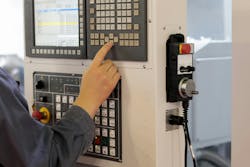HMI and enclosure synergy: Mastering machine workflows for control and safety
Industrial enclosures and human-machine interfaces (HMIs) streamline workflows and boost productivity through multiple features. Centralized control allows operators to monitor processes, troubleshoot issues and adjust parameters directly from a single, protected interface without traveling to multiple locations, reducing downtime and errors. The HMI display delivers real-time feedback in the form of immediate process data, alarms and diagnostics, allowing swift decision-making and minimizing the response time to anomalies.
The intuitive interfaces of touchscreen HMIs provide user-friendly graphics, clear status indications and guided workflows, making command input and data retrieval faster and reducing training requirements for new staff.
For ergonomics and accessibility, enclosures are often designed with adjustable mounting options and optimal screen placement, enhancing operator comfort, reducing fatigue and facilitating more effective interaction with machines. Automation via the HMI reduces the need for manual inspections or direct interaction with hazardous machinery, lightening the operators’ workload and further reducing the risk of human errors.
Materials and NEMA ratings for protection vary, especially in harsh industrial environments. Stainless steel is highly resistant to corrosion, chemicals and impact, making it ideal for environments with corrosive substances, moisture and mechanical stress. Stainless steel helps maintain structural integrity and seal performance critical to environmental protection ratings. Cast aluminum or cast iron is used especially for heavy-duty enclosures rated for hazardous locations, such as NEMA 9, due to their robustness and durability, though they tend to be heavier and more expensive. Non-metallic materials, such as polycarbonate and reinforced thermoplastics, offer resistance to corrosion, UV exposure and impact, while being lighter than metals. They are often used to protect against dust, water and UV damage.
NEMA ratings
NEMA 4: Provides protection against windblown dust, rain, sleet, splashing water and hose-directed water. Suitable for applications with occasional washdowns and machine tool coolant exposure. Offers protection outdoors and indoors with moderate environmental risks.
Get your subscription to Control Design’s daily newsletter.
NEMA 4X: Extends NEMA 4’s protection by adding corrosion resistance. This rating is preferred in harsh and corrosive environments such as food processing, chemical plants and coastal sites where salts and acids are present. NEMA 4X enclosures ensure lasting performance by preventing ingress of dust and moisture along with corrosion protection.
NEMA 3 and 3R: Suitable for outdoor use, these provide protection against falling dirt, rain, sleet and external ice formation. NEMA 3R is generally for enclosures in protected structures but lacks dust-tight sealing, while NEMA 3 offers dust-tight sealing, as well, but is heavier and more rigid.
NEMA 13: Offers protection similar to NEMA 12 but adds oil resistance, making it optimal for environments with oil mist or splashes such as machine shops.
Using stainless steel enclosures rated NEMA 4X is widely considered the most effective choice for harsh environments requiring durability, corrosion resistance and protection from water and dust ingress. For less corrosive but still challenging conditions, NEMA 4 with stainless steel or coated aluminum is suitable. Polycarbonate covers provide lightweight, UV-resistant protection, often used as HMI screen covers.
This combination of robust materials and appropriate NEMA ratings ensures functionality, safety and accessibility, despite harsh industrial environmental challenges.
Industrial enclosures with integrated HMIs create a safer, more efficient work environment. By combining robust physical protection, intuitive controls and real-time feedback within a single unit, they allow operators to interact confidently with complex machinery while minimizing risks and maximizing productivity.
About the Author

Charles Palmer
Charles Palmer is a process control specialist and lecturer at Charles Palmer Consulting (CPC). Contact him at [email protected].

